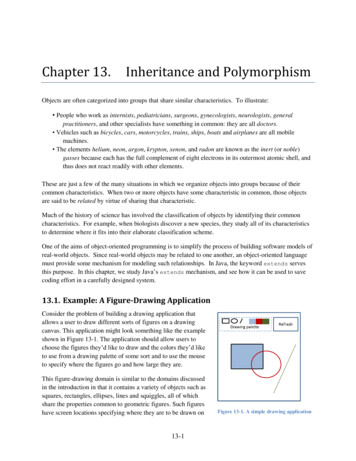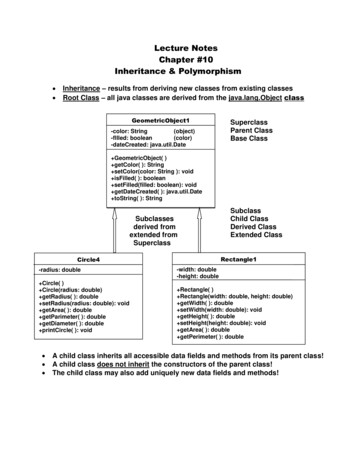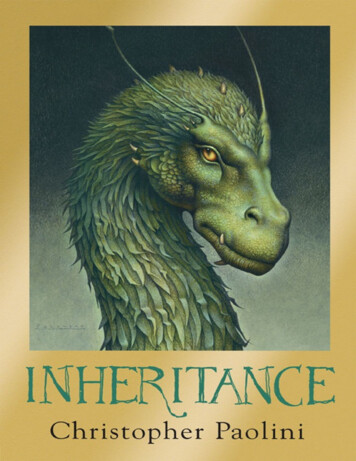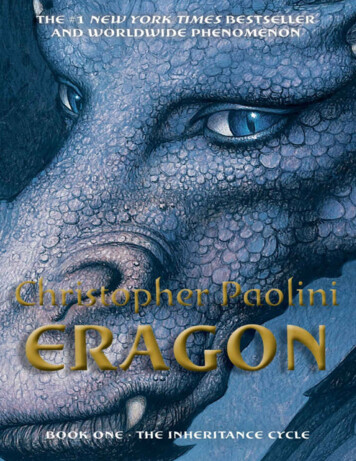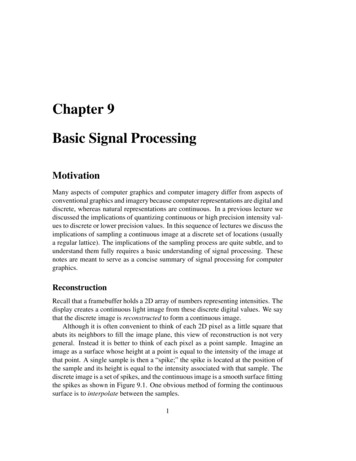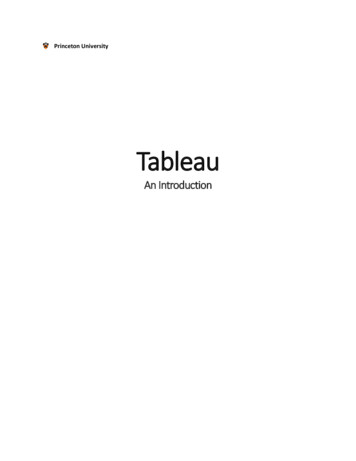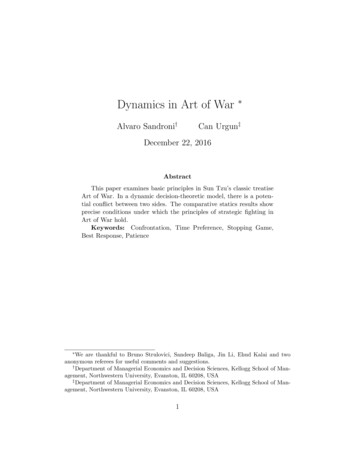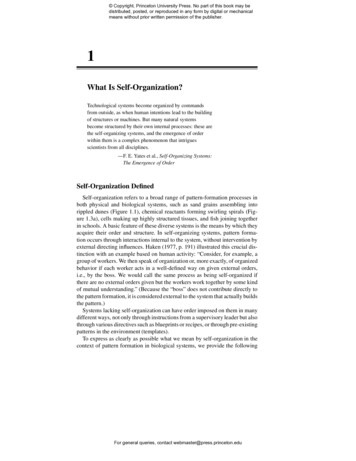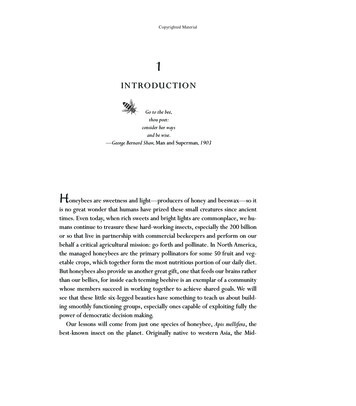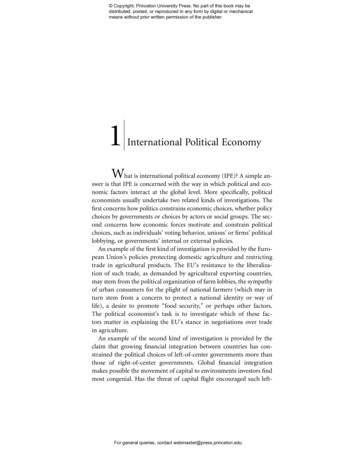
Transcription
COS226 - Spring 2018Class Meeting # 13March 26, 2018Inheritance & PolymorphismIbrahim Albluwi
CompositionA GuitarString has a RingBuffer.A MarkovModel has a Symbol Table.A Symbol Table has a Binary Search Tree.A Deque has a Node.A Node has a Node.A Solver has a Node.A Node has a Board and a Node.A KdTreeST has a Node.A Node has a Point2D and a Node.Code reuse throughComposition.Classes are relatedwith a has-arelationship.
Inheritance is-a Basic OOP Feature!Inheritance!CompositionLanguages that support classes almost always support inheritance. This allows classes to bearranged in a hierarchy that represents "is-a-type-of" relationships.Found in (almost) every Java, C or Python book.Very difficult to find a CS1/CS2 set of courses that does not cover it.But Not covered explicitly in COS126/COS226!Goal Today: — Know what Inheritance and Polymorphism are.— Relate them to what we have seen in 126 and 226 so far.
Warm Up Quiz!http://etc.ch/Vvh7Which of the following is a valid Java Statement?A.Iterable Integer myStack new Stack Integer ();B.Stack Integer myStack new Stack Integer ();C.Object myStack new Stack Integer ();D.A and B only.E.A, B and C.
Warm Up Quiz!http://etc.ch/Vvh7Which of the following is a valid Java Statement?A.Iterable Integer myStack new Stack Integer ();B.Stack Integer myStack new Stack Integer ();C.Object myStack new Stack Integer ();D.A and B only.E.A, B and C.By the end of this class, you will be able to explain whatthese statements mean and what implications they have.
Shapes!
A Circle Class Other Circle methods
A Rectangle Class Other Rectanglemethods
Classes for Shapes-centerX : doublecenterY : doublecolor : Colorradius : double getX(): double getY(): double move(int,int): void setColor(int,int,int): void draw() : String area() : double circumference() : double toString() : String TriangleRectangleCircle--centerX : doublecenterY : doublecolor : Colorwidth : doubleheight : double getX(): double getY(): double move(int,int): void setColor(int,int,int): void draw(): void area() : double circumference() : double toString() : String centerX : doublecenterY : doublecolor : Colorside1 : doubleside2 : doubleside3 : double getX(): double getY(): double move(int,int): void setColor(int,int,int): void draw(): void area() : double circumference() : double
Classes for ShapesCircle- centerX : double- centerY : double- color : Color- radius : double getX(): double getY(): double move(int,int): void setColor(int,int,int): void draw() : String area() : double circumference() : double toString() : String TriangleRectangle- centerX : double- centerY : double- color : Color- side1 : double- side2 : double- side3 : double- centerX : double- centerY : double- color : Color- width : double- height : double getX(): double getY(): double move(int,int): void setColor(int,int,int): void draw(): void area() : double circumference() : double toString() : String getX(): double getY(): double move(int,int): void setColor(int,int,int): void draw(): void area() : double circumference() : double
A Shape Base ClassShape- centerX : double- centerY : double- color : Color getX(): double getY(): double move(int,int): void setColor(int,int,int): void - radius : double TriangleRectangleCircle- width : double- height : double - side1 : double- side2 : double- side3 : double
A Shape Base ClassObservations.(1) Lots of common code between the classes.(2) A Circle is a Shape, so is a Rectangle and a Triangle.Solution.— Create a Shape class that has the common code.— Declare that Circle is a Shape. Do the same for Triangleand Rectangle.— Circle, Triangle and Rectangle inherit the code fromclass Shape.In Java:public class Circle extends Shape { }public class Triangle extends Shape { }public class Rectangle extends Shape { }
Demo!
NotesTerminology.Shape is a parent class, a superclass and a base class.Circle is a child class, a subclass and a derived class.Access Modifiers.Public: Accessible to everyone.Protected: Accessible to subclasses and package.No Modifier: Accessible to package.Super and this.this.xCan be an x in the parent or child class.If both classes have x, this.x refers to thex in the child classsuper.x Always refers to x in the superclass.
What did we gain?Code Reuse!Is-A Relationship!Can do great things!Example 1Example 2Method doSomething accepts anargument of type Shape.
Rules of the GameCircle c new Circle()Reference oftype CircleObject oftype Circlepointing to anCan invoke on c any method in class Circle (or Shape).c.setRadius() — Validc.setColor() — ValidShape c new Circle()Object oftype CircleReference oftype Shapepointing to anCan invoke on c only methods in class Shape.c.setRadius() — Invalidc.setColor() — Valid
Abstract ClassesQ. Do we want to allow instantiating objects of type Shape?If not, then declare class Shape as abstract.Q. Do we want method draw() to be defined in class Shape?Yes! Since all shapes need to be drawn.However, since each shape is drawn differently, draw() should be abstract.An abstract method: Has no body (note the semicolon).Derived classes MUST either be also abstract orimplement all abstract methods in the base class.
Demo!
Quizhttp://etc.ch/Vvh7Assume that Circle overrides method setColor. Which method will getcalled when shapes[0].setColor is called?A.setColor of Shape.B.setColor of Circle.C.The compiler will complain because there are two setColor methods.D.Armagedon.
Quizhttp://etc.ch/Vvh7Assume that Circle overrides method setColor. Which method will getcalled when shapes[0].setColor is called?A.setColor of Shape.B.setColor of Circle.C.The compiler will complain because there are two setColor methods.D.Armagedon.
Welcome PolymorphismWhat?If a subclass defines it’s own version of a base class method(overrides it), the subclass version is invoked if the reference points to anobject of the subclass type.Example.Assume class Circle overrides method setColor in Shape.Shape c new Circle()Object oftype CircleReference oftype Shapepointing to anPolymorphicbehaviorc.setRadius() — InvalidNot a Shape method.c.getX() — ValidImplemented in Shape.c.draw() — ValidAbstract method of Shape.Implemented in Circle.c.setColor() — ValidImplemented in both Shape and Circle.Circle’s version gets called.
Déjà vu!Inheritance & Polymorphismyou have already seen.
The Parent of all ObjectsAll Java classes implicitly extend a class named Objectthat has the following methods:— equals(Object obj)Checks if the object is equal to obj.— toString()Returns a string representationof the object.— hashCode()Returns a hash code valuefor the object.— clone()Returns a copy of theobject.— getClass()Returns the type of theobject.— Others
The Parent of all ObjectsWhen you implement equals or toString, you are actuallyoverriding the default implementation of equals and toString inthe Object class.Default Implementations.Equals():Reference comparison of memory locations usingthe operator.ToString():A String made of the class name ‘@‘ hashCode().The default implementation of hashCode returns thememory location of the object.Circle c1 new Circle()c1.equals(c2) — ValidUses default implementation of Object.c1.toString() — ValidA default implementation in Object andanother in Circle.Uses the implementation in Circle.
QuizConsider.Circle c1 new Circle()Explain.How does Java handle the following two lines of ing())Answer.Method print is overloaded:Calls method toString on obj.Polymorphism in action!
Again What did we gain?by inheriting state and behavior from parent class.Code Reuse!Is-A Relationship!A promise for an APIand Polymorphism!through abstract methodsWhat if we care only about these? Define an abstract class whereall methods are abstract.Or Define and use an interface!
Welcome Interfaces!Instead of:public abstract classpublic abstractpublic abstractpublic abstractpublic abstract }Shape {double getX();double getY();void draw();void setColor(int, int, int);Implement:public interface Shape {double getX();double getY();void draw();void setColor(int, int, int); }All methods are implicitly:public abstract.All fields are implicitly:public static final
Examples of Interfaces in Java 7public interface Iterable T {Iterator T Iterator(); }public interface Iterator T {boolean hasNext();T next(); }Use with interfacesimplementsinstead ofextendspublic interface Comparable T {int compareTo(T other);}public interface Cloneable {}Empty! Useful onlyfor Is-A relationship
Interfaces in Java 8In Java 8, methods in interfaces are allowed to have a defaultimplementation.Question. What is the difference between an abstract class and aninterface with default implementations?Answer.extending a classimplementing an interfaceInherits API, state andimplementation.Inherits only API andimplementation.Multiple InheritanceNOT allowed.Multiple Inheritance allowed.A class can extend only one class, but can implement several interfaces.I.e., a class can be only one thing, but can play several roles!
Back to the Warm Up Quiz!Which of the following is a valid Java Statement?Only iterator() can be invokedSameTypeA Stack is Iterable.A.Iterable Integer myStack new Stack Integer ();B.Stack Integer myStack new Stack Integer ();C.Object myStack new Stack Integer ();D.A and B only.E.A, B and C.A Stack is an Object.Only Object methodscan be invoked
DiscussionWhat is the difference between using Generics and using Object?Example. public class Queue {public void enqueue(Object obj) { }public Object dequeue() { }}v.s.public class Queue T {public void enqueue(T element) { }public T dequeue() { }}Queue Integer qT new Queue Integer ();Queue qObj new Queue();Type Safe.qT.enqueue(myCat); // does not compile!Not Type Safe.qObj.enqueue(myCat); // compiles!No Need to Cast.Needs a Cast.int element qT.dequeue();int element (Integer) qObj.dequeue();
Abusing Inheritance1. Extending for implementation. To extend, Is-A should holdExample 1. Make class Percolation extend class BeadFinder to make use of theDFS method. Bad idea! A Percolation object is not a BeadFinder.Example 2. Make class Polygon extend class Circle to make use of getX(),getY(), setColor(), etc. Bad idea! A Polygon is not a Circle.2. Methods or variables in base class not relevant in subclasses.Example. Adding instance variable radius and method getRadius in class Shape.Bad idea! Useful for Circle, Oval but not for Triangle and Polygon.3. Hierarchies that are long and complicated.Hierarchies should be wide, not deep!
Inheritance Wars!Anti-Inheritance ClanInheritance violates encapsulation.Child class knows too much aboutParent class.Widely abused.Leads to absurdities, especially withmultiple inheritance.Anti-Anti-Inheritance ClanInheritance is useful.Model’s real world entities morenaturally.Code carefully and avoid abuse.Code difficult to test and debug.Widely Used Rules of Thumb:— Favor Composition over Inheritance.— Use Composition for code re-use and implement interfaces fordefining Is-A relationships.
Image on the first slide retrieved on March 25th from: /patterns-of-inheritance 2014 v4.jpg
Inheritance is-a Basic OOP Feature! Found in (almost) every Java, C or Python book. Very difficult to find a CS1/CS2 set of courses that does not cover it. But Not covered explicitly in COS126/COS226! Goal Today: — Know what Inheritance and Polymorphism are. — Relate them to what we have seen in 126 and 226 so far. Inheritance!
